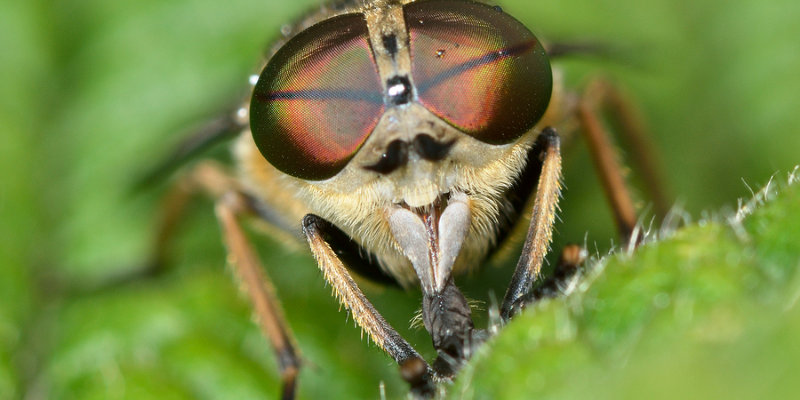There are over 100 species of horse and deer flies known to occur in Texas. Eyes of live specimens are often beautifully colored with iridescent and metallic color patterns. Deer flies (Chrysops spp., 33 species) range from 1/4 to ½ inch long, black to brown in coloration, often with yellowish markings. They characteristically have clear wings with black or brown patterns, making wings appear to be banded. Horse flies (Tabanus, 52 species, and other genera) range from 3/8 to just over 1 inch long and vary in coloration by species. Some are all black while many have colored patterns on their abdomens and wings.

- Few flies can be confused with horse and deer flies. Few other robust flies are capable of biting man and animals. The stable fly, Stomoxys calcitrans (Linnaeus) (Diptera: Muscidae), another common biting fly, superficially resembles the house fly except that the mouthparts (proboscis) protrude bayonet-like forward from underneath the head. Non-biting males and other less common non-biting s
- Winter is spent as partially grown larvae that pupate in spring and begin emerging as adults in late spring and summer, varying by species. Females often lay eggs in specific locations, such as on vegetation overhanging water. Eggs are laid in masses that darken to brown or black before larvae hatch out and drop to the ground or into water. Larvae are generally whitish, spindle-shaped and develop through six to thirteen stages (instars) over one or more years before pupating. One generation per year occurs for most species.
- Larvae have chewing or tearing mouthparts; adult female mouthparts are modified for piercing and sucking blood. Adult females of many horse and deer fly species are attracted to man and animals in search of a blood meal, although a blood meal may not be necessary to produce the first cluster of eggs. Males are nectar feeders and often hover at certain times of the day, presumably to attract females and maintain a territory. Species are often locally abundant near breeding habitats, and the various species have distinctive adult activity periods during the year and/or during the day. Larvae live in species specific habitats, although most are aquatic, semi-aquatic or terrestrial. They are generally predaceous and cannibalistic, feeding on other insect larvae and earthworms, although some (particularly deer fly larvae) may feed on plant matter.
- Adult horse and deer flies can be collected by swinging an insect net around one’s head while walking through an infested area, such as along a wooded path, near swampy areas, on the beach or other bodies of water at the right time of the year. Special traps, such as malaise traps, baited with a source of carbon dioxide (e.g., dry ice) and visually attracting objects (e.g., a black plastic sheet or sphere) are very effective for obtaining large numbers of specimens. Larvae can be collected along water edges by sifting mud and washing plant roots in a screen-bottomed bucket or box.
- Adults bite animals and man; biting activities can be annoying in outdoor areas, and the bites can be very painful and remain swollen for several days; incessant attacks on livestock can reduce weight gain; capable of mechanically transmitting some animal diseases (e.g., anaplasmosis).
At Longhorn Termite & Pest Control, we offer horse fly control services for customers in Azle, Weatherford, Benbrook, and Graham, Texas.
